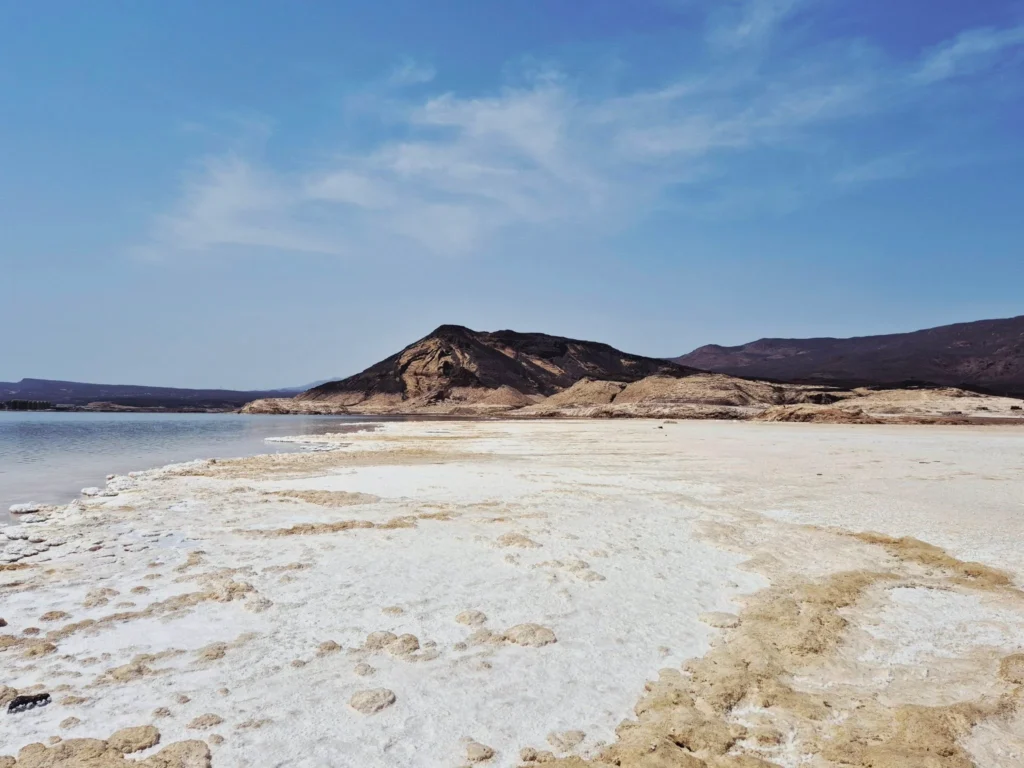Djibouti is a tiny spot on the Horn of Africa that packs a punch with some crazy stuff you wouldn’t expect. It’s not all fancy resorts or postcard beaches; it’s rough, hot, and full of weird wonders that make you do a double-take. From the lowest place you can stand on the continent to a port that keeps a whole country alive, plus some spooky rock towers and giant fish you can swim with, this place has got character. Here’s the lowdown on what Djibouti’s known for, how to see it, and why it’s a big deal.
Famous Things in Djibouti (Short Version)
- Lake Assal: The Lowest spot in Africa at 509 feet below sea level, with super salty water and white salt flats. Looks wild, 155 kilometers west of the capital—tourists love the alien vibe.
- Port of Djibouti: Key shipping spot on the Bab el-Mandeb Strait, handles Ethiopia’s trade and millions of tons yearly. New terminal stacks 1.5 million containers.
- Military Bases: U.S., France, China, Japan, and Italy have bases here—Camp Lemonnier is the big U.S. one, bringing in $63 million a year.
- Lac Abbé Chimneys: Spooky limestone spires, some 165 feet tall, near a lake 140 kilometers southwest. Flamingos and steam make it a photo hotspot.
- Afar Triangle: Where tectonic plates split, with the colorful Dallol Depression—brown, orange, green pools from volcanic heat.
- Running Stars: Ahmed Salah won big marathons in the ‘80s—dry land trains tough runners, and the Djibouti Marathon’s a local pride thing.
- Ancient Punt: Might be part of the old Land of Punt, where Egyptians traded 4,500 years ago—cave paintings at Balho show old wildlife.
- Khat Chewing: Folks chew this leafy buzz from Ethiopia daily—roadside stalls sell it, and it’s a social kick.
- Whale Sharks: Gulf of Tadjoura’s got 40-foot whale sharks to swim with, November to January—crazy coral too.
- French Touch: French colonial leftovers—street signs, croissants with spicy fish, and the Djibouti Palace hotel add a unique twist.
Lake Assal: Africa’s Deepest Drop
Lake Assal is 509 feet below sea level, the lowest spot you can hit in Africa and third lowest worldwide, just behind some Middle East spots. It’s 155 kilometers west of Djibouti City, a bumpy desert ride that feels like you’re heading to Mars. The water’s so salty—way more than the ocean—that it’s got this greenish tint from tiny critters living in it, and the white salt flats look like cracked snow under the blazing sun, which can hit 120°F. Tourists love floating in it (bring tough shoes, the salt stings your feet) and snapping pics with the volcanic hills behind. The Afar people have been scraping salt here for ages, trading it with Ethiopia for coffee or food. It’s harsh, but that’s what makes it stand out.

Port of Djibouti: Trade Lifeline
The Port of Djibouti is the workhorse sitting on the Bab el-Mandeb Strait, where the Red Sea meets the Gulf of Aden. It’s Ethiopia’s gateway since they’ve got no coast, shoving millions of tons of stuff—grains, fuel, gear—through every year. The Doraleh Container Terminal’s the new beast, stacking 1.5 million containers with cranes working nonstop. China dumped $600 million into it, so it’s a global deal, not just local. If you’re in Djibouti City, you can see the ships from the waterfront—big rusty hulls and guys hauling crates. It’s loud, dirty, and keeps the region moving.
Military Bases: World’s Hotspot
Djibouti’s a military playground with bases from the U.S., France, China, Japan, and Italy all crammed close. Camp Lemonnier’s the U.S. giant, with 4,000 troops and pumping $63 million into the economy yearly. France has an old-school base from colonial times, China’s got a shiny new one since 2017, and Japan’s got a small anti-piracy spot. Italy and others pop in with planes or ships. It’s a tense mix, all eyeing the busy Red Sea lanes. You won’t get inside—security’s tight—but you’ll see jeeps rolling through town and bars packed with soldiers. It’s a weird clash of global muscle and dusty roads.

Lac Abbé Chimneys: Ghostly Towers
Lac Abbé, 140 kilometers southwest of Djibouti City, has these limestone chimneys that look like something from a horror movie—some hit 165 feet, spewing steam from hot springs underneath. It’s in the Afar Triangle where the ground’s splitting, and the chimneys are old mineral leftovers. Flamingos strut around the salty lake, turning it pink, and the sunrise lights up the spires like a dream shot. Getting there’s a grind—7 hours in a 4×4, dodging quicksand—but camping in Afar huts under the stars is a trip. They filmed Planet of the Apes here, and that eerie feel still hangs around.
Afar Triangle: Earth Splitting Apart
The Afar Triangle’s where the African, Arabian, and Somali plates are tearing away, making a messy split in the crust. Inside, the Dallol Depression’s a riot of colors—brown, orange, green pools from volcanic heat and sulfur, with temps pushing 140°F. The ground’s a mix of salt flats and lava, like you’re on another planet. Scientists geek out here studying how continents break, and it’s raw as hell. You can’t just stroll in—tours from Djibouti City are a must, and the heat’ll test your guts. It’s nature doing its wild thing, no filters needed.
Running Stars: Tough Runners
Djibouti’s dry, tough land churns out runners like Ahmed Salah, who crushed marathons in the ‘80s—winning Boston twice and snagging Olympic bronze. The altitude (around 1,500 feet) and heat build grit, and the Djibouti Marathon in February pulls locals to race through dusty streets. It’s not some big event with banners—just pride, with kids training barefoot on dirt. The winner might score a goat or some cash. If you’re there, check the start near the stadium—it’s sweaty and real, a slice of local life.
Ancient Punt: Old Trade Spot
Djibouti might’ve been part of the ancient Land of Punt, where Egyptians traded gold and incense 4,500 years back. Cave paintings at Balho, 100 kilometers east of the capital, show giraffes and rhinos—animals long gone—hinting at a lush past. Experts argue if Punt stretched here, but the art and old port ruins suggest it was a hub. You can hike to Balho with a guide, climbing rocks to see the faded drawings. It’s a rough peek into history, tying Djibouti to old tales.
Khat Chewing: Local High
Khat’s the daily buzz here—a leafy chew from Ethiopia that gives a jittery lift, like a weak energy drink. Roadside stalls sell bundles for a few bucks, and folks—drivers, friends—munch it to stay awake or chat. It turns teeth green over time and kills hunger for a few hours. It’s legal locally but banned in the U.S. and Europe, so don’t smuggle it. Walk through Djibouti City markets, and you’ll smell the fresh piles—it’s a social glue, rough around the edges.

Whale Sharks: Giant Swim Buddies
The Gulf of Tadjoura, a two-hour boat ride from Djibouti City, is where 40-foot whale sharks roll in from November to January. These chill giants eat plankton, and you can snorkel with them—tours run $100-$150 with outfits like Dolphin Excursions. The coral’s a bonus, with colorful fish and turtles in clear water. It’s not a sure thing—you might chase them in small boats—but the odds are decent. Bring a rash guard; the sun’s brutal, and the swim’s a rush.
French Touch: Colonial Leftovers
French rule from 1896 to 1977 left a quirky stamp—French street signs, croissants with spicy fish, and the Djibouti Palace hotel with its faded glory. You’ll hear French in the markets, see old colonial buildings near the port, and taste weird food fusions at cafes. The hotel’s a relic—cracked floors, sea views, and a bar where expats sip pastis. It’s a messy blend of Africa and France, rough but one-of-a-kind.
What Makes Djibouti Tick
These 10 things—Lake Assal, Port of Djibouti, Military Bases, Lac Abbé Chimneys, Afar Triangle, Running Stars, Ancient Punt, Khat Chewing, Whale Sharks, and French Touch—give Djibouti its edge. It’s not shiny or crowded, and that’s the point. The heat, the isolation, and the mix of old and new make it stand out. You can float in Lake Assal, watch port chaos, or swim with whale sharks—each spot’s a story. Getting around’s a hassle; 4x4s or tours are key, and it ain’t cheap. Spend a week, take some pics, and you’ll get why it’s famous—tough, real, and unlike anywhere else.

